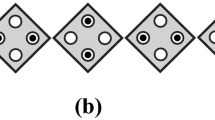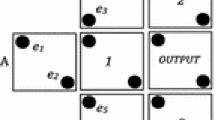Abstract
Quantum-dot cellular automata (QCA) offer a promising design paradigm for complementing conventional integrated circuits. The XOR plays a crucial role in arithmetic circuits and communications. Existing design schemes consume more operational components and thus are inefficient in terms of area and QCA cost at present. In this paper, a coplanar XOR composed of an NAND-NOR-Inverter (NNI) and a five-input majority voter (M5) is proposed for the first time. This new structure not only excludes complex crossovers but also has full accessibility to its input/output pins. The simulation waveforms and performance figures verify the functionality and merits of the proposed circuits. The implementation of the proposed XOR scheme in QCA consumes less overhead than that of its counterparts. Its occupied area and QCA cost are respectively reduced by 9.26% and 33.33% compared with the state-of-the-art XOR. To prove its practicability, multi-bit parity generators are also proposed in the means of hierarchically cascading the proposed XOR gates. The area and cost of the proposed 32-bit generator are respectively reduced by 39.47% and 33.33% compared with the existing best design.
















Similar content being viewed by others
References
Khouri, K.S., Jha, N.K.: Leakage power analysis and reduction during behavioral synthesis. IEEE Trans. Very Large Scale Integr. VLSI Syst. 10(6), 876–885 (2002). https://doi.org/10.1109/TVLSI.2002.808436
Adan, A.O., Higashi, K., Fukushima, Y.: Analytical threshold voltage model for ultrathin SOI MOSFETs including short-channel and floating-body effects. IEEE Trans. Electron Devices. 46(4), 729–737 (1999). https://doi.org/10.1109/16.753707
Awano, Y., Sato, S., Nihei, M., Sakai, T., Ohno, Y., Mizutani, T.: Carbon nanotubes for VLSI: interconnect and transistor applications. Proc. IEEE. 98(12), 2015–2031 (2010). https://doi.org/10.1109/JPROC.2010.2068030
Anu, Sharma, A., Khan, M.S., Srivastava, A., Husain, M., Khan, M.S.: High-performance single-electron transistor based on metal–organic complex of thiophene: first principle study. IEEE Trans. Electron Devices. 64(11), 4628–4635 (2017). https://doi.org/10.1109/TED.2017.2756106
Lent, C.S., Tougaw, P.D.: A device architecture for computing with quantum dots. Proc. IEEE. 85(4), 541–557 (1997). https://doi.org/10.1109/5.573740
Tougaw, P.D., Lent, C.S.: Logical devices implemented using quantum cellular automata. J. Appl. Phys. 75(3), 1818–1825 (1994). https://doi.org/10.1063/1.356375
Riente, F., Turvani, G., Vacca, M., Roch, M.R., Zamboni, M., Graziano, M.: ToPoliNano: a CAD tool for Nano magnetic logic. IEEE Trans. Comput. Aided Des. Integr. Circuits Syst. 36(7), 1061–1074 (2017). https://doi.org/10.1109/TCAD.2017.2650983
Pulimeno, A., Graziano, M., Sanginario, A., Cauda, V., Demarchi, D., Piccinini, G.: Bis-Ferrocene molecular QCA wire: Ab initio simulations of fabrication driven fault tolerance. IEEE Trans. Nanotechnol. 12(4), 498–507 (2013). https://doi.org/10.1109/Tnano.2013.2261824
Livadaru, L., Xue, P., Shaterzadeh-Yazdi, Z., DiLabio, G.A., Mutus, J., Pitters, J.L., Sanders, B.C., Wolkow, R.A.: Dangling-bond charge qubit on a silicon surface. New J. Phys. 12, 1–15 (2010). https://doi.org/10.1088/1367-2630/aa8b88
Pitters, J.L., Livadaru, L., Haider, M.B., Wolkow, R.A.: Tunnel coupled dangling bond structures on hydrogen terminated silicon surfaces. J. Chem. Phys. 134(6), 1–6 (2011). https://doi.org/10.1063/1.3514896
Kawai, H., Ample, F., Wang, Q., Yeo, Y.K., Saeys, M., Joachim, C.: Dangling-bond logic gates on a Si(100)-(2 x 1)-H surface. J. Phys.-Condes. Matter. 24(9), 1–13 (2012). https://doi.org/10.1088/0953-8984/24/9/095011
Walus, K., Dysart, T.J., Jullien, G.A., Budiman, R.A.: QCADesigner: a rapid design and simulation tool for quantum-dot cellular automata. IEEE Trans. Nanotechnol. 3(1), 26–31 (2004). https://doi.org/10.1109/TNANO.2003.820815
Navi, K., Farazkish, R., Sayedsalehi, S., Rahimi Azghadi, M.: A new quantum-dot cellular automata full-adder. Microelectron. J. 41(12), 820–826 (2010). https://doi.org/10.1016/j.mejo.2010.07.003
Chabi, A.M., Roohi, A., Khademolhosseini, H., Sheikhfaal, S., Angizi, S., Navi, K., DeMara, R.F.: Towards ultra-efficient QCA reversible circuits. Microprocess. Microsyst. 49, 127–138 (2017). https://doi.org/10.1016/j.micpro.2016.09.015
Farazkish, R., Azghadi, M.R., Navi, K., Haghparast, M.: New method for decreasing the number of quantum dot cells in QCA circuits. World Appl. Sci. J. 4(6), 793–802 (2008)
Berarzadeh, M., Mohammadyan, S., Navi, K., Bagherzadeh, N.: A novel low power exclusive-OR via cell level-based design function in quantum cellular automata. J. Comput. Electron. 16(3), 875–882 (2017). https://doi.org/10.1007/s10825-017-0986-7
Momenzadeh, M., Huang, J., Tahoori, M.B., Lombardi, F.: Characterization, test, and logic synthesis of and-or-inverter (AOI) gate design for QCA implementation. IEEE Trans. Comput. Aided Des. Integr. Circuits Syst. 24(12), 1881–1892 (2005). https://doi.org/10.1109/TCAD.2005.852667
Zhang, R., Walus, K., Wang, W., Jullien, G.A.: A method of majority logic reduction for quantum cellular automata. IEEE Trans. Nanotechnol. 3(4), 443–450 (2004). https://doi.org/10.1109/TNANO.2004.834177
Zhang, R., Gupta, P., Jha, N.K.: Majority and minority network synthesis with application to QCA-, SET-, and TPL-based nanotechnologies. IEEE Trans. Comput. Aided Des. Integr. Circuits Syst. 26(7), 1233–1245 (2007). https://doi.org/10.1109/TCAD.2006.888267
Kong, K., Shang, Y., Lu, R.: An optimized majority logic synthesis methodology for quantum-dot cellular automata. IEEE Trans. Nanotechnol. 9(2), 170–183 (2010). https://doi.org/10.1109/TNANO.2009.2028609
Wang, P., Niamat, M.Y., Vemuru, S.R., Alam, M., Killian, T.: Synthesis of majority/minority logic networks. IEEE Trans. Nanotechnol. 14(3), 473–483 (2015). https://doi.org/10.1109/TNANO.2015.2408330
Soeken, M., Amaru, L.G., Gaillardon, P.E., De Micheli, G.: Exact synthesis of majority-inverter graphs and its applications. IEEE Trans. Comput. Aided Des. Integr. Circuits Syst. 36(11), 1842–1855 (2017). https://doi.org/10.1109/tcad.2017.2664059
Abedi, D., Jaberipur, G.: Decimal full adders specially designed for quantum-dot cellular automata. IEEE Trans. Circuits Syst. II Express Briefs. 65(1), 106–110 (2018). https://doi.org/10.1109/TCSII.2017.2703942
Perri, S., Corsonello, P., Cocorullo, G.: Area-delay efficient binary adders in QCA. IEEE Trans. Very Large Scale Integr. VLSI Syst. 22(5), 1174–1179 (2014). https://doi.org/10.1109/TVLSI.2013.2261831
Kianpour, M., Sabbaghi-Nadooshan, R.: A novel quantum-dot cellular automata X-bit × 32-bit SRAM. IEEE Trans. Very Large Scale Integr. VLSI Syst. 24(3), 827–836 (2016). https://doi.org/10.1109/TVLSI.2015.2418278
Taskin, B., Hong, B.: Improving line-based QCA memory cell design through dual phase clocking. IEEE Trans. Very Large Scale Integr. VLSI Syst. 16(12), 1648–1656 (2008). https://doi.org/10.1109/TVLSI.2008.2003171
Mustafa, M., Beigh, M.R.: Design and implementation of quantum cellular automata based novel parity generator and checker circuits with minimum complexity and cell count. Indian J. Pure Appl. Phys. 51(1), 60–66 (2013). https://doi.org/10.1140/epjh/e2012-30008-3
Kianpour, M., Sabbaghi-Nadooshan, R., Navi, K.: A novel design of 8-bit adder/subtractor by quantum-dot cellular automata. J. Comput. Syst. Sci. 80(7), 1404–1414 (2014). https://doi.org/10.1016/j.jcss.2014.04.012
Khosroshahy, M.B., Moaiyeri, M.H., Angizi, S., Bagherzadeh, N., Navi, K.: Quantum-dot cellular automata circuits with reduced external fixed inputs. Microprocess. Microsyst. 50, 154–163 (2017). https://doi.org/10.1016/j.micpro.2017.03.009
Singh, G., Sarin, R.K., Raj, B.: A novel robust exclusive-OR function implementation in QCA nanotechnology with energy dissipation analysis. J. Comput. Electron. 15(2), 455–465 (2016). https://doi.org/10.1007/s10825-016-0804-7
Angizi, S., Alkaldy, E., Bagherzadeh, N., Navi, K.: Novel robust single layer wire crossing approach for exclusive OR sum of products logic design with quantum-dot cellular automata. J. Low Power Electron. 10(2), 259–271 (2014). https://doi.org/10.1166/jolpe.2014.1320
Sasamal, T.N., Ghanekar, U., Singh, A.K.: Design and analysis of ultra-low power QCA parity generator circuit. In: Garg, A., Bhoi, A., Sanjeevikumar, P., Kamani, K. (eds.) Lecture Notes in Electrical Engineering, vol. 436, pp. 347–354. Springer, Singapore (2018)
Sheikhfaal, S., Angizi, S., Sarmadi, S., Moaiyeri, M.H., Sayedsalehi, S.: Designing efficient QCA logical circuits with power dissipation analysis. Microelectron. J. 46(6), 462–471 (2015). https://doi.org/10.1016/j.mejo.2015.03.016
Mohammadi, H., Navi, K.: Energy-efficient single-layer QCA logical circuits based on a novel XOR gate. J. Circuits Syst. Comput. (2018). https://doi.org/10.1142/S021812661850216X
Poorhosseini, M., Hejazi, A.R.: A fault-tolerant and efficient XOR structure for modular design of complex QCA circuits. J. Circuits Syst. Comput. 27(7), 1–24 (2017). https://doi.org/10.1142/S0218126618501153
Chaudhary, A., Chen, D.Z., Hu, X.S., Whitton, K., Niemier, M., Ravichandran, R.: Eliminating wire crossings for molecular quantum-dot cellular automata implementation. In: ICCAD-2005. IEEE/ACM International Conference on Computer-Aided Design, 2005, San Jose, 6–10 Nov. 2005, pp. 565–571. IEEE
Chung, W.J., Smith, B., Lim, S.K.: QCA physical design with crossing minimization. In: 5th IEEE conference on nanotechnology, 2005, Nagoya, 15–15 July 2005, pp. 108–111. IEEE
Smith, B.S., Lim, S.K.: QCA channel routing with wire crossing minimization. In: 2005 ACM Great Lakes symposium on VLSI, GLSVLSI'05, Chicago, IL, United states, April 17–19, 2005 2005. Proceedings of the ACM Great Lakes Symposium on VLSI, GLSVLSI, pp. 217–220. Association for Computing Machinery
Krishnaswamy, S., Viamontes, G.F., Markov, I.L., Hayes, J.P.: Probabilistic transfer matrices in symbolic reliability analysis of logic circuits. ACM Trans. Des. Autom. Electron. Syst. 13(1), 1–8 (2008). https://doi.org/10.1145/1297666.1297674
Srivastava, S., Sarkar, S., Bhanja, S.: Estimation of upper bound of power dissipation in QCA circuits. IEEE Trans. Nanotechnol. 8(1), 116–127 (2009). https://doi.org/10.1109/TNANO.2008.2005408
Liu, W., Lu, L., Oneill, M., Swartzlander, E.E.: A first step toward cost functions for quantum-dot cellular automata designs. IEEE Trans. Nanotechnol. 13(3), 476–487 (2014). https://doi.org/10.1109/TNANO.2014.2306754
Acknowledgements
This work is supported by the Fundamental Research Funds for the Central Universities of China (No. JZ2019HGTB0092).
Author information
Authors and Affiliations
Corresponding author
Additional information
Publisher’s Note
Springer Nature remains neutral with regard to jurisdictional claims in published maps and institutional affiliations.
Rights and permissions
About this article
Cite this article
Zhang, Y., Deng, F., Cheng, X. et al. A Coplanar XOR Using NAND-NOR-Inverter and Five-Input Majority Voter in Quantum-Dot Cellular Automata Technology. Int J Theor Phys 59, 484–501 (2020). https://doi.org/10.1007/s10773-019-04343-w
Received:
Accepted:
Published:
Issue Date:
DOI: https://doi.org/10.1007/s10773-019-04343-w




